Predictive SEO: Forecasting Rankings with AI
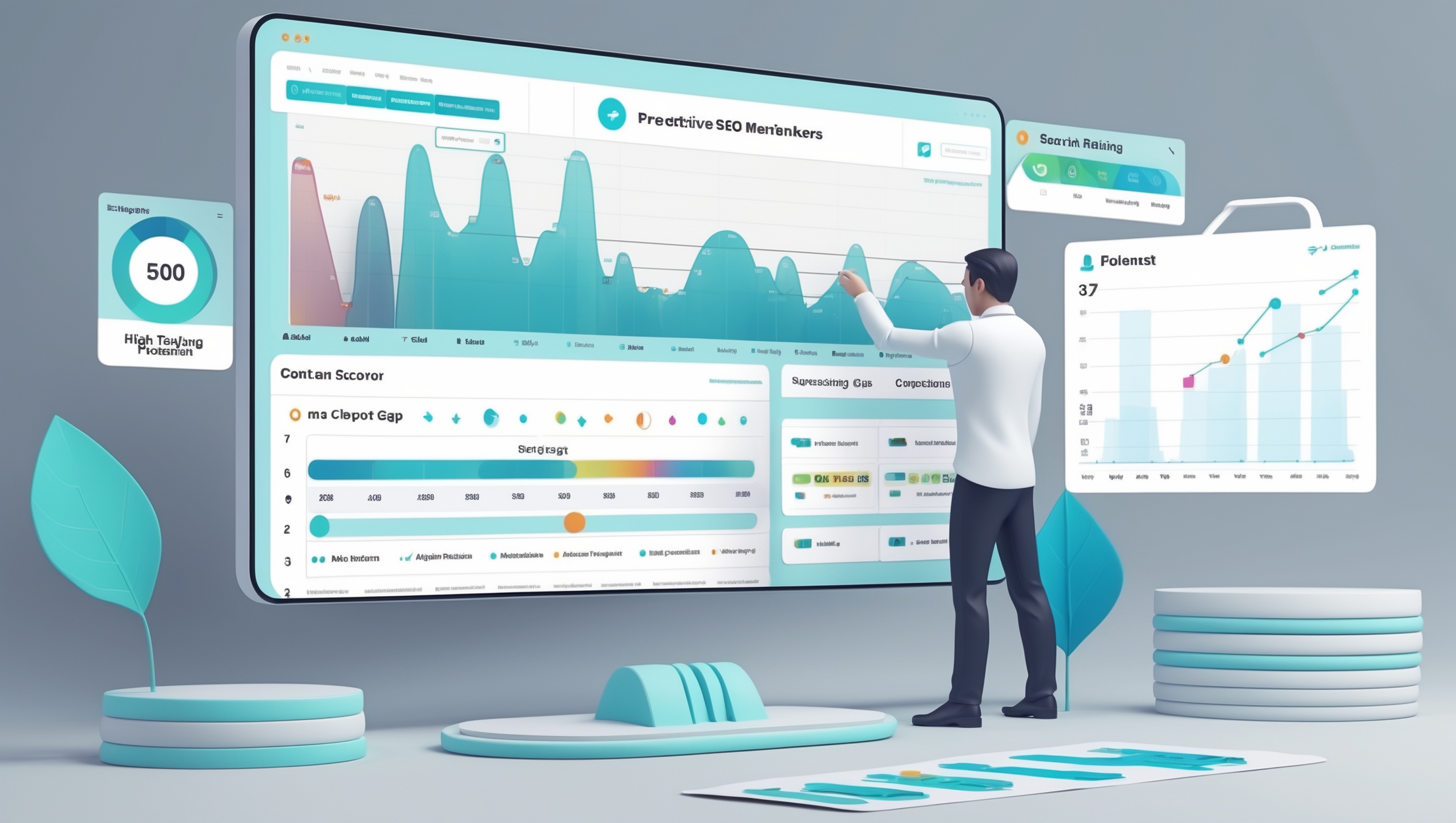
SEO isn’t just about reacting anymore—it’s about anticipating. With predictive SEO, marketers are no longer waiting for traffic drops or algorithm updates to hit; they’re using AI to see them coming.
By combining historical data with real-time signals, modern SEO forecasting tools can project rankings, search volume changes, and content needs weeks in advance. That gives you time to adjust your strategy before competitors even realize there’s a shift.
This isn’t guesswork. AI in SEO prediction uses machine learning models to identify patterns in search behavior, ranking volatility, and on-page engagement. It’s the difference between playing offense versus defense in an increasingly competitive digital landscape.
And it goes beyond rankings—content performance prediction helps you forecast which blog posts, landing pages, or product categories are likely to convert based on historical trends and intent signals. In short, predictive SEO is how smart SEOs stay ahead.
What Is Predictive SEO and How Does It Work?

Let’s break it down simply: predictive SEO is the practice of using AI and data models to anticipate how your rankings, traffic, and search behavior will evolve before they actually do. It’s a proactive approach to SEO, built on data, not guesswork.
Traditionally, SEO has been reactive. We publish content, wait for Google to index it, monitor the rankings, and make changes based on what happens. But today, with tools that support AI in SEO prediction, we can start seeing future outcomes before those outcomes are even visible in analytics.
This all comes down to one thing—data interpretation at scale. Machine learning for SEO allows systems to sift through massive historical datasets like keyword trends, click-through rates, and user behavior signals, then recognize the patterns that humans would typically miss.
The real power lies in how these insights can guide decisions. Say you notice a slow but steady decline in traffic to a high-performing post. A predictive model might identify the cause isn’t competition or algorithm updates—but a shift in search engine trend analysis where the user intent is evolving.
We had a client in the health niche who saw a 20% drop in rankings over two months. Traditional SEO would blame backlinks or content decay. But their AI tool revealed a rising trend of voice search queries phrased differently than their existing content. They updated headlines and structure—and the rankings rebounded in just three weeks.
These tools don’t just focus on rankings either. Many also use traffic prediction models to estimate when seasonal content will spike, how long it might take to rank, and whether it's worth updating versus rewriting. This is where predictive SEO starts to align directly with ROI.
Here’s what a typical prediction workflow might include:
- Pulling 6–12 months of keyword and page data
- Layering on real-time ranking movement
- Comparing against industry-wide SERP volatility
- Running outcomes through an ML-based scoring model
Some platforms even integrate Google Search Console and GA4 data to refine those projections over time. It’s like having a forecasting dashboard for your entire SEO strategy.
At the end of the day, predictive SEO isn’t replacing what you know—it’s giving you visibility you’ve never had before. And in a search environment that changes daily, that insight is what gives you the edge.
Key Signals and Data Inputs Used in Forecasting
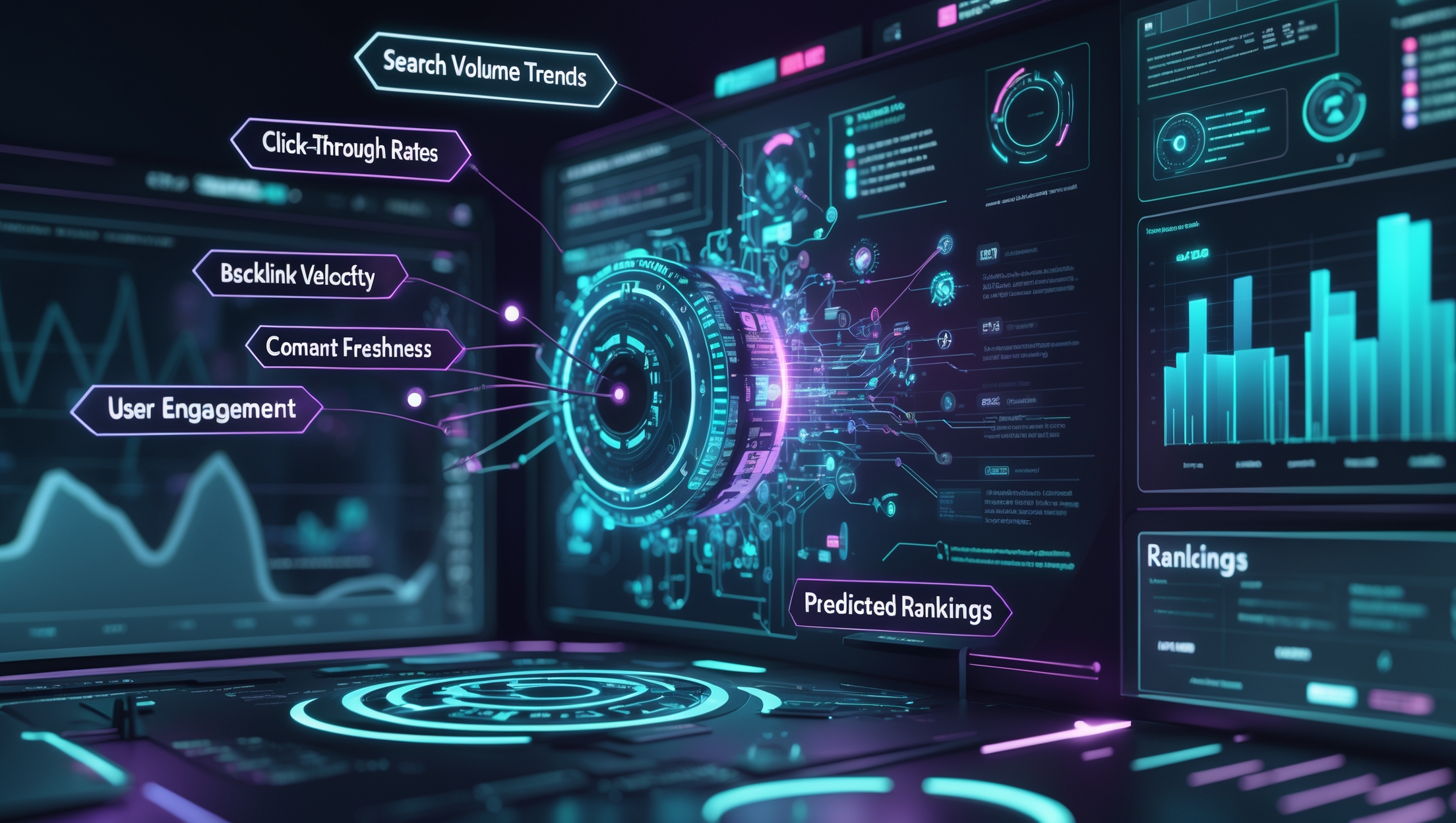
Understanding the data inputs that fuel predictive SEO is essential to using it effectively. These signals help AI models estimate future ranking outcomes, often more accurately than human intuition.
The first major input is historical ranking data. Tools like Ahrefs, SEMrush, and Nightwatch store months—even years—of rank tracking, which can be used to model expected position changes over time.
Second, we rely on real-time SEO analytics that show how users interact with content as it lives and breathes on the web. Google Analytics 4, for instance, offers engagement metrics like average engagement time and scroll depth, which help AI detect early signs of performance drops.
Another critical input is click-through rate (CTR) across specific keyword SERPs. According to Backlinko’s CTR study, the #1 result in Google gets an average CTR of 27.6%—a baseline figure that helps AI spot anomalies that might signal content decay or shifting intent 【Source: Backlinko, 2023】.
A lesser-known signal is ranking velocity, or how quickly a URL is gaining or losing positions. Fast upward movement across multiple keywords might mean an emerging topic is gaining traction—something AI can flag faster than manual monitoring ever could.
Also valuable are ranking position predictors—machine learning tools that factor in over 200 ranking signals to project where a page might end up. These predictors are especially useful during content refreshes or post-algorithm update audits.
Natural Language Processing (NLP) also plays a significant role in SEO forecasting. Tools like Clearscope and MarketMuse use NLP to assess keyword density, topical relevance, and entity coverage—indicators that heavily influence Google’s semantic understanding of a page.
Let’s say you run a finance blog. AI tools analyzing NLP in SEO forecasting might reveal that your article on “retirement planning” is missing key semantic entities like “401k limits” or “Roth IRA.” Filling those gaps can help you gain topical relevance before rankings dip.
Don’t overlook seasonality data, especially for e-commerce or event-driven niches. If your product category typically peaks in Q4, your predictive model can flag when to start content updates and paid campaigns based on past performance trends.
Another useful signal is competitor content movement. Tools like SISTRIX and SEOTesting let you monitor when competitors update content, gain SERP features, or earn new backlinks—all helpful for content performance prediction in your niche.
Search volatility indices like the SEMrush Sensor or MozCast also serve as macro-level forecasting tools. They help contextualize whether a drop in rankings is site-specific or part of a broader algorithmic shift, saving you from making unnecessary site-wide changes.
In short, predictive SEO doesn’t rely on just one metric—it requires a mosaic of data signals across content, engagement, competitors, and intent. The better your data inputs, the smarter your forecasting engine becomes.
Benefits of Predictive SEO for Modern Marketers
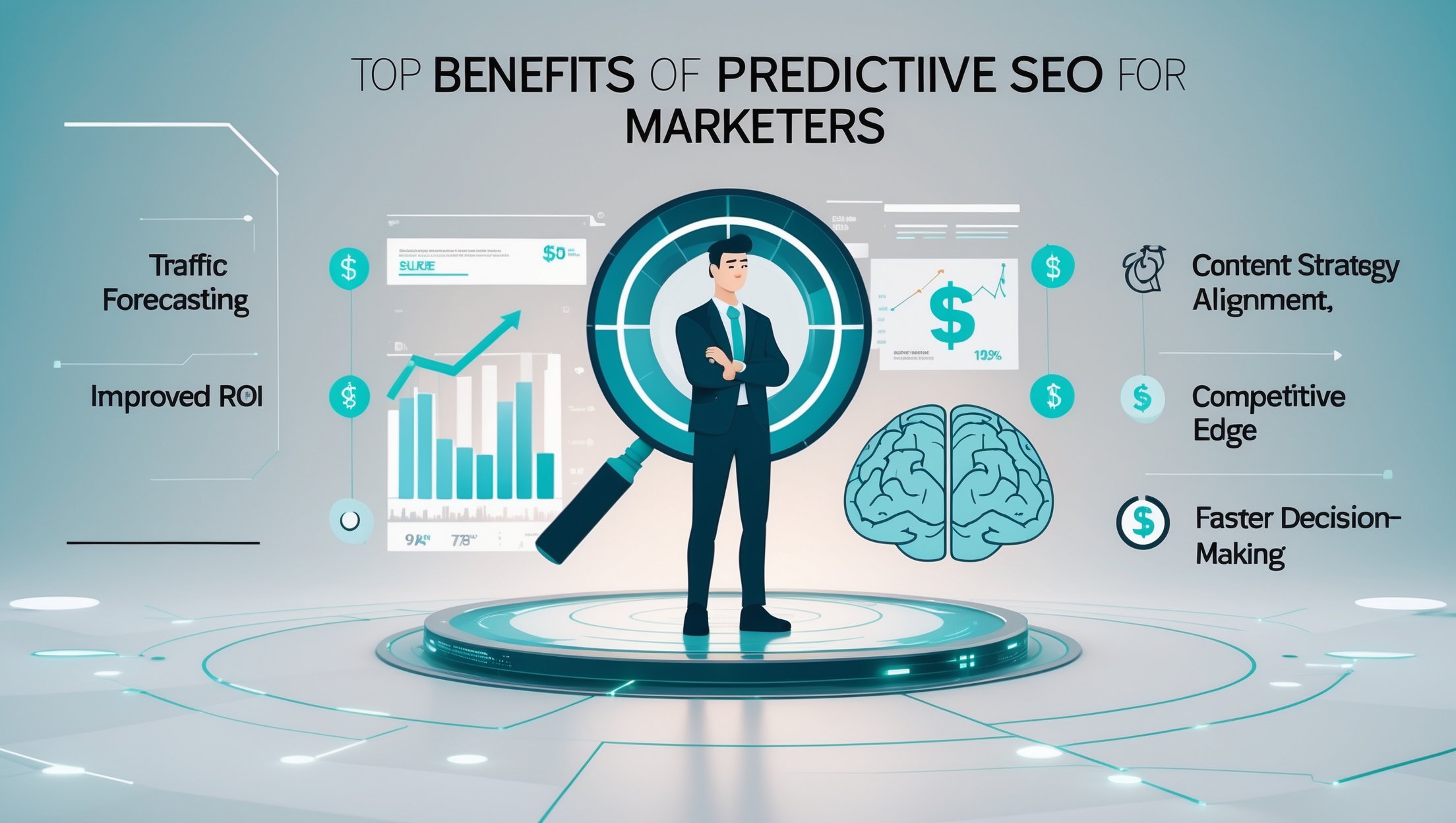
Faster, Data-Backed Decision Making
In the world of SEO, speed matters—but so does accuracy. With AI SEO strategy planning, you get both.
Predictive SEO lets you take decisive action before rankings dip or traffic crashes. Instead of waiting to see the damage, AI can alert you to early warning signs using trend data, user engagement signals, and historical rankings.
That means you can refresh content, update targeting, or add new sections before the algorithm takes notice. It’s no longer about reacting fast—it’s about acting early.
Smarter Content Planning with Real ROI
One of the biggest wins for marketers? Knowing which content is likely to succeed before it goes live. With content performance prediction, you’re not writing blind anymore.
AI models evaluate similar top-ranking content, intent match, keyword difficulty, and engagement history to forecast how well your next article or landing page will perform. This is a huge shift for teams investing in long-form, data-driven content.
Let’s say you're targeting "best productivity tools for 2025." A predictive model might flag low demand, high competition, and outdated phrasing. That gives you a chance to pivot the topic—or position it better—before wasting time and budget.
Better Alignment with Evolving Search Intent
As search evolves, so do user expectations. And that’s where search intent forecasting becomes a game-changer.
AI can detect subtle shifts in how people phrase queries or the types of results that Google is favoring. Maybe a query that used to return listicles now shows more video results or feature snippets. If you’re not tracking that shift, your rankings could vanish overnight.
By aligning content with predicted intent—informational, transactional, or navigational—you not only improve your chances of ranking but also boost engagement and conversion.
Reducing Traffic Drops Before They Happen
No one likes waking up to a traffic crash. But with modern traffic prediction models, those surprises can be minimized—or avoided altogether.
These models use past performance data combined with real-time SEO metrics to forecast when traffic might slow down. Whether it’s due to seasonality, competitor updates, or algorithm volatility, you’ll know ahead of time.
For example, a B2C retail brand noticed declining traffic to a top-performing gift guide. Before rankings dropped significantly, the AI flagged a seasonal trend shift and recommended reoptimizing for “2025 gift ideas.” A 15-minute edit helped them retain their top 3 position.
Automating Priorities with AI
Marketers are drowning in data, but tools offering automated SEO insights help cut through the noise. These platforms surface high-impact actions you should take—like updating a title, adding internal links, or revising content depth—without you needing to dig through dashboards for hours.
It’s like having a strategist and analyst working 24/7 in the background. The best part? These suggestions often come with predicted impact scores, so you can prioritize based on potential ROI.
Improving Predictability in Long-Term Strategy
Planning 6–12 months ahead has always been tricky in SEO. But with ranking position predictors, you gain clearer insight into how certain keywords and pages are likely to trend over time.
This helps you map realistic growth targets, budget allocations, and content velocity. Instead of guessing which topics will perform, you can stack your roadmap with high-potential opportunities.
One marketing agency I worked with used predictive data to build an entire pillar-cluster content calendar for Q1. Not only did they hit their traffic goals—they exceeded them by 28%, with fewer published posts than the previous year.
In short, predictive SEO isn’t just a technical advantage—it’s a strategic one. It empowers marketers to act confidently, back their choices with data, and stay two steps ahead of both algorithms and competitors.
SERP Volatility and Algorithm Forecasting
What Is SERP Volatility—and Why Should You Care?
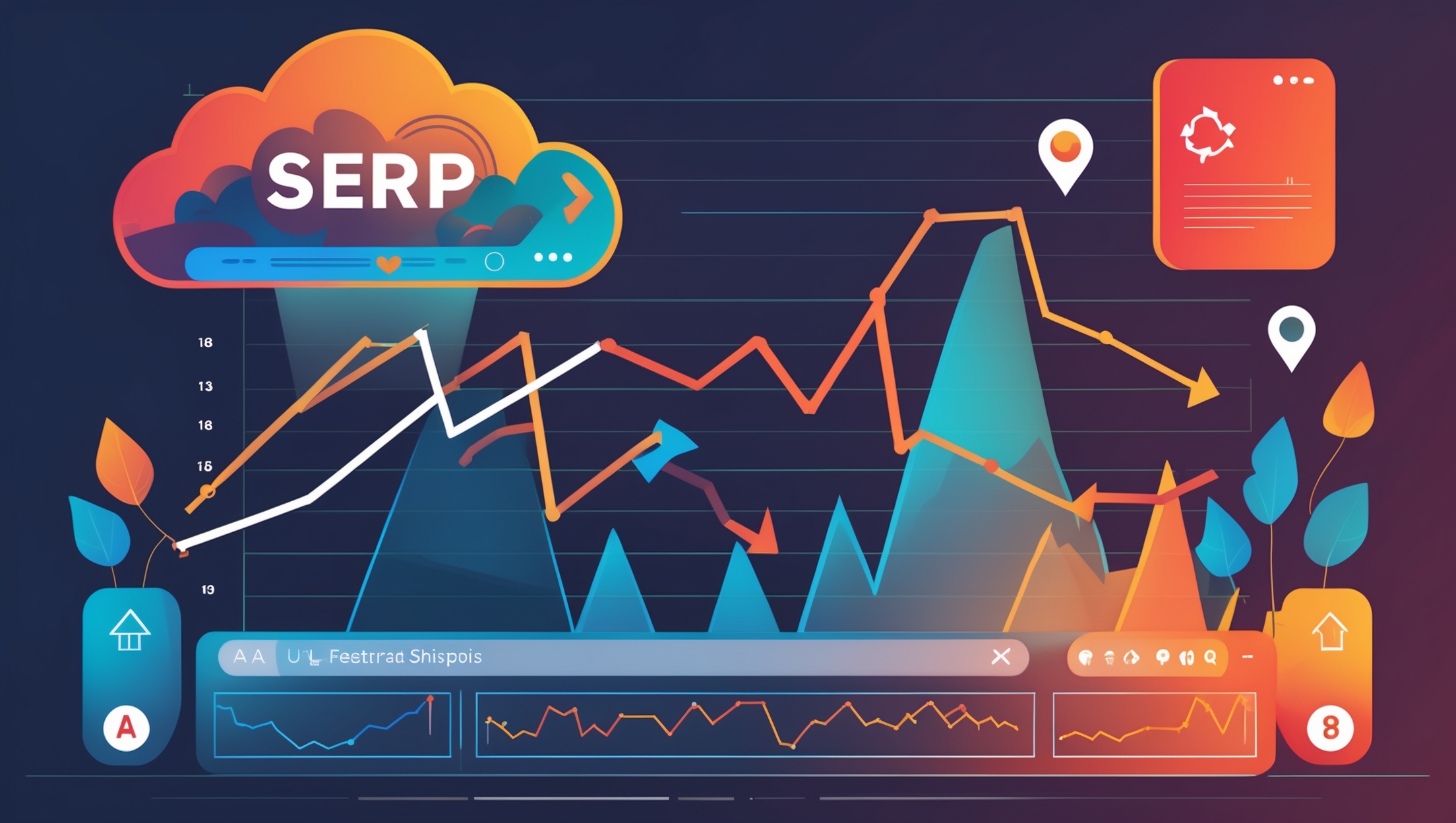
Search engine results pages (SERPs) change constantly, and sometimes unpredictably. One day you’re ranking in position #2, and the next, you’ve dropped to #9 with no clear explanation.
That’s SERP volatility, and it’s driven by hundreds of factors—algorithm updates, competitors updating content, new backlinks, or even shifts in search intent. It’s why many SEOs live with one eye on rank trackers and one hand on their panic button.
With SERP fluctuation alerts, predictive tools now notify you of ranking instability as it happens. These alerts allow you to investigate quickly and adjust before your traffic takes a hit.
Detecting Algorithmic Shifts Before the Industry Does
Traditionally, SEOs waited for confirmation from MozCast or Google itself to know if an update happened. But with algorithm change forecasting, AI tools can now analyze SERP volatility patterns and flag anomalies within hours—sometimes days—before the wider SEO community notices.
For example, tools like Semrush Sensor or CognitiveSEO's Signals monitor fluctuations across thousands of keywords daily. If they detect unusual ranking shifts across multiple industries, it’s likely a core update is underway—even if Google hasn’t announced anything yet.
An enterprise blog I worked with caught an update early using this kind of signal. They paused planned content releases, reviewed all pages gaining or losing traction, and adjusted headings and metadata across 80+ posts. When the dust settled, they were among the few sites to maintain their positions.
How Google Ranking Predictions Work in Practice

Not all volatility is algorithmic—some of it’s just Google adjusting how it interprets content or user behavior. That’s where Google ranking predictions help SEOs stay informed without overreacting.
Modern ranking position predictors combine engagement data (like bounce rate, CTR), on-page signals, and search trend shifts to forecast your future position. If a high-performing article is showing declining time on page or rising pogo-sticking, AI might predict a future drop—even if your position is stable today.
That’s powerful. It means you can proactively revise structure, update examples, or improve the value of your content while you’re still ahead.
Understanding Industry-Wide Trends vs. Site-Specific Issues
One of the hardest things in SEO is figuring out: “Is this just happening to me?”
This is where search engine trend analysis comes into play. Predictive platforms help differentiate between site-level changes and broader shifts happening across your industry or keyword set.
For instance, if your article on “best productivity tools” drops in rankings but competitor articles drop too, it may indicate a SERP reshuffle rather than a penalty. That insight gives you clarity—and prevents overcorrection.
From Panic to Preparation
What used to be SEO firefighting is now intelligent response. Predictive SEO turns SERP volatility into a signal, not a setback.
With the right tools in place, you're no longer guessing or chasing forums for answers. You're adapting in real time, using forecasting models built around real user data, not hunches.
Whether you’re managing one site or fifty, predictive SEO gives you a clearer picture of where you’re headed—and how to avoid getting blindsided by the next wave of algorithm updates.
Top AI Tools for Predictive SEO
Why Tools Matter in Predictive SEO
Predictive SEO isn’t just about theory—it lives and breathes through the tools you use. Without the right stack, you’re flying blind.
Modern SEO forecasting tools harness AI, NLP, and massive datasets to analyze trends, track fluctuations, and project future rankings. The best platforms don't just report metrics—they generate insights you can act on.
Let’s walk through some of the most effective tools marketers and SEO pros are using right now.
1. Semrush Sensor – Monitoring SERP Turbulence
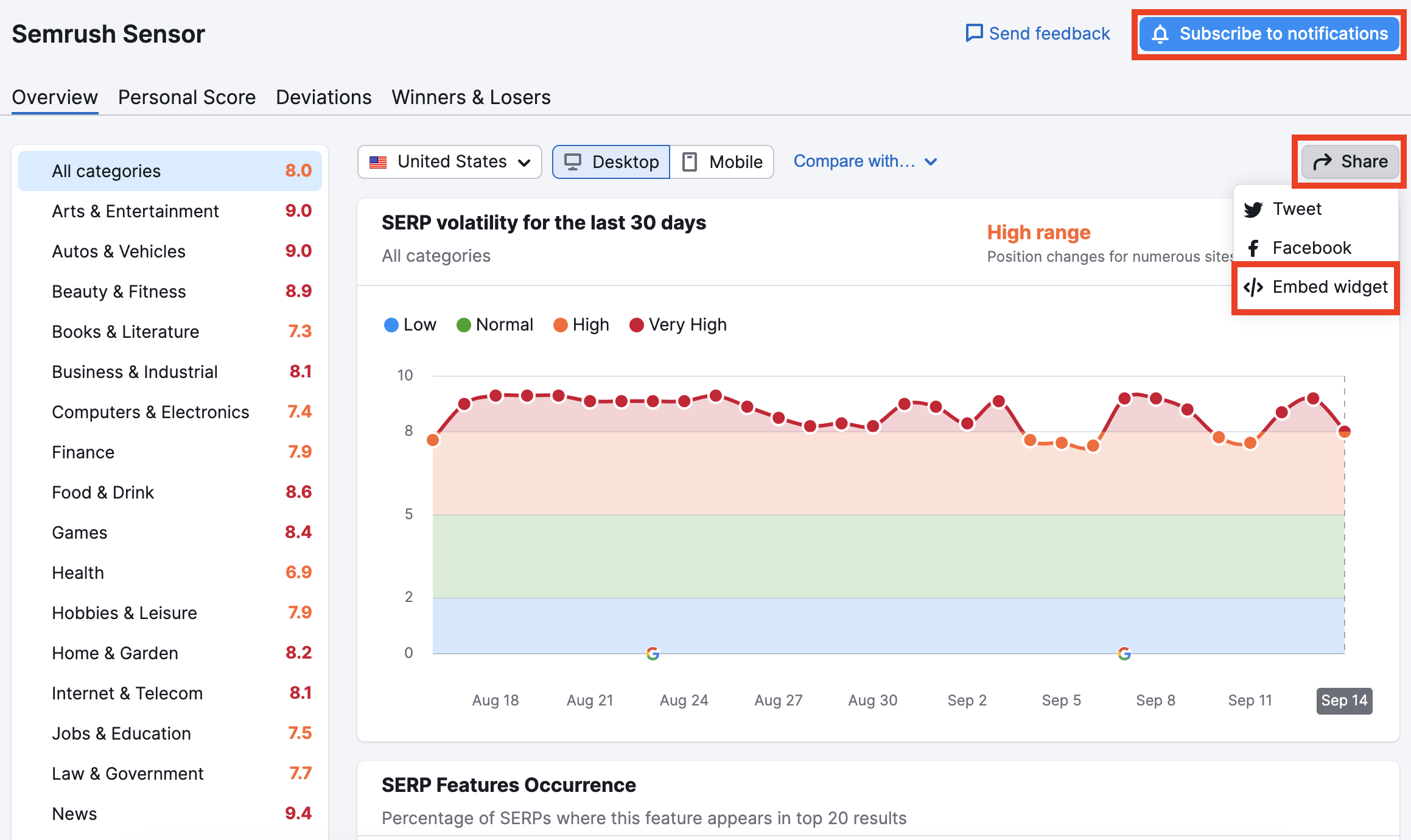
Semrush Sensor is one of the most well-known ranking position predictors. It monitors keyword volatility across industries, showing whether rankings are stable or in flux.
If the sensor spikes, it likely signals an algorithm update or major content reshuffling. Combined with domain-level analytics, it gives you early visibility into threats before your traffic suffers.
2. SEOTesting – Trend Monitoring for Specific URLs
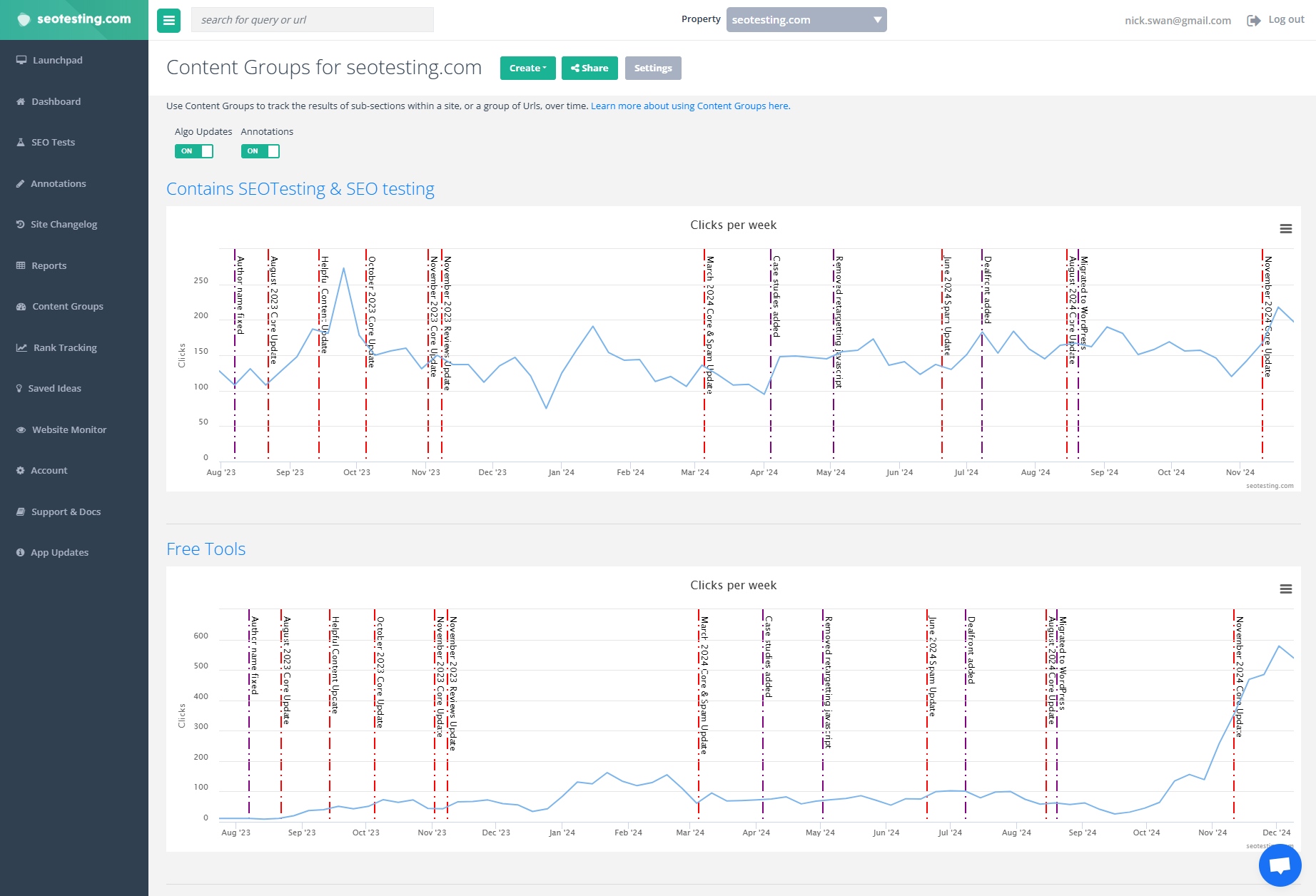
SEOTesting is a lightweight but powerful tool focused on content-level testing and forecasting. It tracks how content changes affect rankings and helps build traffic prediction models based on your own site’s data.
A great use case: you optimize a blog post with updated headers and schema. SEOTesting can isolate that test, monitor rank movement, and validate whether the change worked—all without guesswork.
3. Surfer SEO + Jasper AI – Content Forecasting Power Duo
Pair Surfer SEO (for SERP and NLP analysis) with Jasper AI (for generative writing), and you get a content engine with predictive capabilities baked in.
Surfer analyzes search intent, topical authority, and competitors’ structures. Jasper generates content based on those signals. Together, they offer automated SEO insights like content score projections and keyword gap coverage before publishing.
One of my agency clients uses this stack to plan their monthly blog pipeline. They target only articles forecasted to score 70+ on Surfer—resulting in a 34% lift in organic traffic quarter-over-quarter.
4. MarketMuse – Strategy and Content Scoring with AI
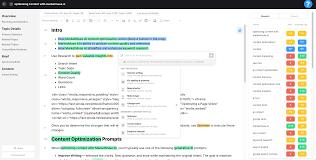
MarketMuse is a true strategist’s tool. It uses AI-powered SEO dashboards to map topical authority, forecast ROI of content, and prioritize pages that need attention.
Unlike basic keyword tools, MarketMuse works at the domain level, showing which content assets are underperforming, why, and what to publish next. If you’re managing a large content library, this is gold.
5. Clearscope – Real-Time SEO Forecasting for Writers
Clearscope is a writer-friendly tool that delivers AI tools for organic search optimization while you're building content. It analyzes semantic coverage, competition, and readability, offering a real-time content score with predictive elements.
While it’s not a traditional “forecasting” tool, it helps predict how well content will perform based on how closely it matches SERP expectations and topic depth.
Choosing the Right Stack
No single tool covers everything. Your choice depends on your workflow.
- Want AI-driven content briefs? Go with Surfer or MarketMuse.
- Need volatility alerts? Use Semrush Sensor.
- Prefer real-world testing and traffic projections? Try SEOTesting.
If you’re running a large site or agency, combining multiple tools often gives the best results. Together, they turn predictive SEO from a concept into a repeatable system.
Practical Use Cases & Forecasting Workflows
Why Use Cases Matter More Than Theory
It’s easy to talk about predictive SEO in abstract terms. But the real value is in how you apply it—daily—to improve rankings, content efficiency, and strategic planning.
Modern SEO forecasting tools are designed to plug directly into your workflows. That means they don’t just analyze—they guide your next move.
Forecasting New Content Before It Goes Live
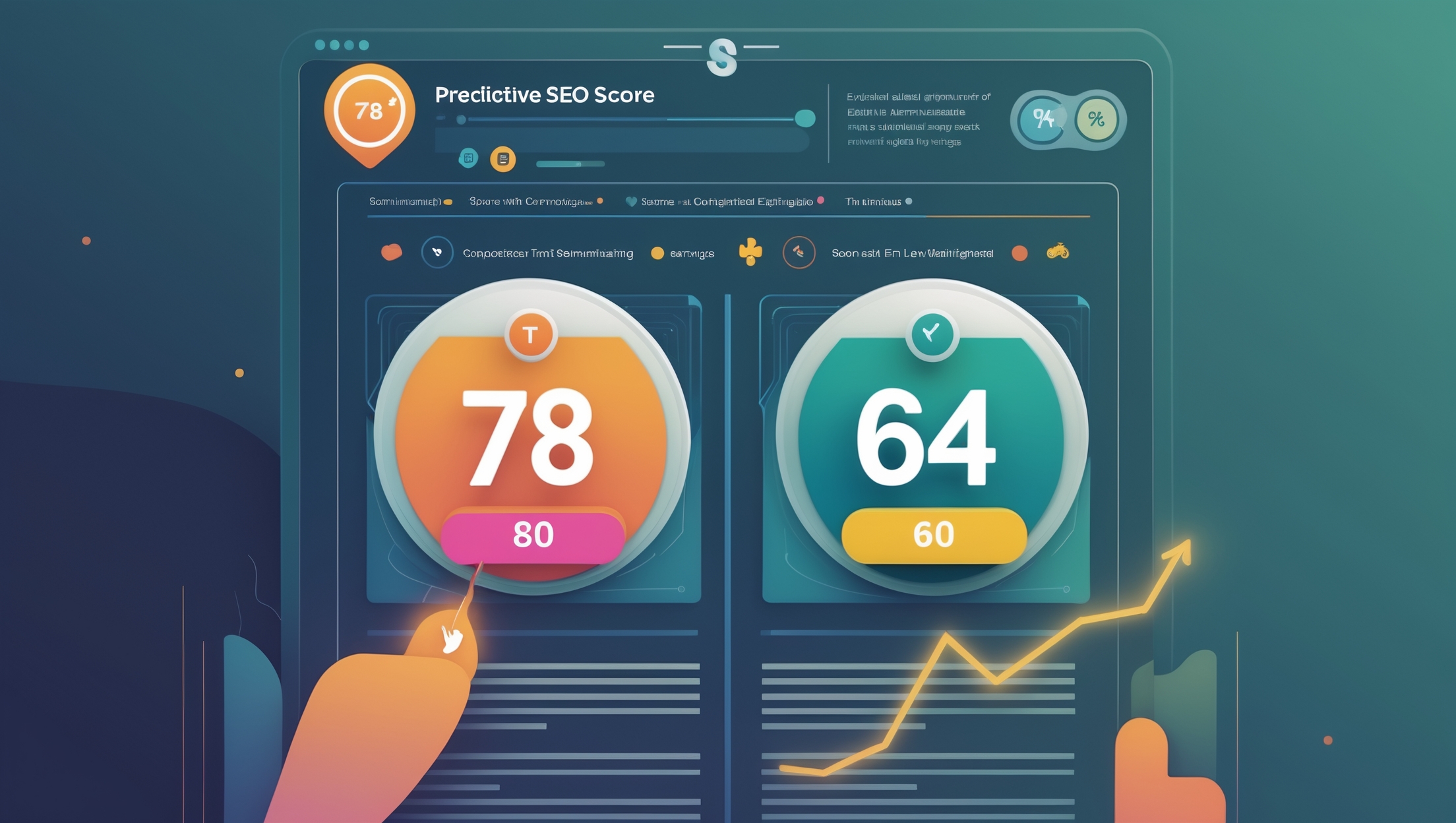
Before you hit publish, wouldn’t it be helpful to know how well a piece of content might perform? That’s where content performance prediction shines.
Tools like Surfer or MarketMuse provide predictive scoring based on semantic depth, competitor analysis, and search intent match. If your outline or draft isn’t likely to rank, you’ll know before wasting hours building it.
One client of mine used Surfer to test two article variations—one scored 78, the other 64. They only published the higher scorer. The result? A 22% higher click-through rate in the first month.
Refreshing Existing Content Strategically
Content decay happens to everyone—but guessing what to refresh is inefficient. With automated SEO insights, tools like SEOTesting or Clearscope can highlight decaying articles based on impression loss, engagement dips, and rank volatility.
Using this data, you can prioritize updates that will yield actual ROI, not just vanity metrics. For example, if your blog on “remote productivity tools” dropped from position 3 to 8, AI might suggest semantic gaps based on emerging keywords like “AI productivity assistants.”
Update the subheadings, add a new section, and you may regain lost ground quickly—without rewriting the whole thing.
Using Predictive Keyword Modeling for Opportunity Discovery
Keyword research is no longer just about volume—it’s about potential. With predictive keyword modeling, AI looks beyond current metrics and evaluates ranking opportunity based on volatility, search intent shifts, and SERP structure.
Building AI-Powered Dashboards to Track Forecasts
Instead of jumping between platforms, many teams are now building AI-powered SEO dashboards in Looker Studio, Tableau, or custom interfaces. These dashboards consolidate keyword trend data, traffic projections, and competitor changes in one place.
When layered with ranking position predictors, you get a command center for decision-making. You can see what’s rising, what’s falling, and what needs immediate attention.
Even better—set automated alerts based on thresholds (e.g., traffic down 15%, ranking drop >2 positions), and assign these directly to content or SEO teams for fast turnaround.
Building a Forecasting Workflow from Scratch
Here’s a simple step-by-step you can follow:
- Collect historical performance data (Google Search Console, GA4)
- Feed that into your forecasting tool of choice
- Identify patterns and high-risk assets
- Validate predictions by comparing to recent SERP movements
- Prioritize updates and new content based on scoring
- Monitor using automated alerts and dashboards
The goal is to stop treating SEO like a postmortem process. With forecasting, you're shaping what happens before it happens.
Common Challenges and Limitations of Predictive SEO
AI Isn’t Always Right—And That’s a Problem
We love the power of machine learning for SEO, but let’s be honest—AI isn’t perfect. Sometimes it picks up patterns that aren’t meaningful, or misinterprets seasonal spikes as long-term trends.
Just like weather forecasting, SEO forecasting has a margin of error. Predictive models are only as good as the data they’re trained on—and they can’t read future algorithm updates that haven’t rolled out yet.
Overreliance on Predictive Scores Can Be Misleading
Tools that provide ranking position predictors and content scores are incredibly useful—but they shouldn’t replace strategic thinking. A high-scoring page might look promising in the tool but fail to perform due to technical debt, off-page factors, or search intent mismatch.
One ecommerce site I worked with relied heavily on Surfer content scores. They launched a batch of high-score posts, but traffic was flat. Why? The keywords had transactional intent, but the content was purely informational. Predictive scoring didn’t catch the mismatch—only human review did.
False Positives in Traffic Models
Not every dip in traffic means a post is failing. Some traffic prediction models overreact to short-term drops or small data sets.
If you’re working with low-volume keywords or a newer site, the model might interpret natural variation as a negative trend. This can lead to unnecessary content rewrites or strategy pivots that burn time and resources.
The fix? Pair your SEO forecasting tools with good old-fashioned common sense. Check Search Console and GA4 trends over 90 days, not just the past week.
Contextual Blind Spots in Automated Insights
While automated SEO insights are great for catching anomalies, they often lack nuance. They won’t know, for instance, that you intentionally unpublished a post—or that your campaign was geo-targeted.
This makes blind automation dangerous. I’ve seen clients auto-apply meta description changes from an AI tool, only to wipe out carefully crafted brand messaging.
Always build a layer of human QA into your forecasting workflows. AI can recommend, but you should still decide.
Content Scoring Doesn’t Equal Business Impact
Content performance prediction might tell you which post is likely to rank—but it won’t always tell you which one converts. SEO forecasting still needs to align with business KPIs like leads, signups, and sales.
A high-ranking blog post that brings 10,000 visitors is meaningless if none of them buy. Predictive tools rarely account for backend data like CRM attribution or user journey mapping.
That’s why marketers should link SEO dashboards with revenue dashboards to get the full picture—not just surface-level metrics.
Model Bias, Incomplete Data & One-Size-Fits-All Logic
Finally, it’s important to remember: AI models are trained on someone else's idea of "normal." If you operate in a niche market or an emerging industry, your SERPs don’t behave like others.
Many SEO forecasting tools are built for B2C, high-volume environments. If you're doing B2B or local SEO, the predictions may lack relevance—or miss the nuances that matter in smaller data sets.
Bottom line? Predictive SEO is powerful, but not flawless. Think of it as a second brain—not a replacement for yours.
How to Get Started with Predictive SEO (Action Plan)
Start Simple: Collect and Clean Your Data
Before jumping into tools and automation, you need a solid foundation—your existing SEO data. Pull the last 6–12 months of rankings, traffic, impressions, and conversions from Google Search Console and GA4.
Make sure the data is clean and consistent. Pages with missing metadata, broken links, or poor structure can throw off your model’s predictions from the start.
Identify Your Priority Pages and Keywords
Not every page needs forecasting. Focus first on your core content—pillar pages, commercial landing pages, and traffic-generating blog posts.
You can use ranking position predictors or your own rank tracking history to identify pages that have fluctuated recently or sit just outside the top 3. These are great candidates for predictive analysis.
Choose the Right Forecasting Tools
Now it’s time to build your forecasting stack. Depending on your goals, you might need tools for predictive keyword modeling, content performance prediction, or volatility monitoring.
Here are some suggestions:
- Surfer SEO / Clearscope – for NLP-based content forecasting
- SEOTesting – for testing and visualizing ranking shifts
- Semrush Sensor – for detecting industry-wide volatility
- MarketMuse – for AI-driven topic planning and ROI projections
- Looker Studio / Tableau – to build AI-powered SEO dashboards
If you're just starting out, pick one tool that fits your primary need and layer others in as your workflow grows.
Build a Forecasting Workflow
Once your tools are in place, build a weekly or monthly routine that includes:
- Reviewing page-level ranking trends
- Monitoring CTRs and bounce rates
- Checking automated SEO insights from your forecasting tools
- Prioritizing which URLs or keywords to update or expand
- Mapping new topics based on predictive keyword modeling
The key is consistency. Predictive SEO isn’t just a one-time insight—it’s a habit that compounds over time.
Align Forecasts with Your SEO Strategy
All the predictions in the world are useless if they’re not tied to your larger SEO goals. Use the data to power AI SEO strategy planning—where each action supports a defined goal (rank retention, SERP growth, keyword expansion, etc.).
One example: if your model flags declining traffic for a key product page, don’t just update it—consider re-optimizing the funnel, refreshing internal links, and launching supporting content.
Pro Tip: Automate What You Can, Review What You Should
Automation helps you scale, but don’t go full autopilot. Even the best SEO forecasting tools need human judgment to interpret nuance, context, and business goals.
Set up email alerts or Slack integrations that push reports to your team. That way, when a page crosses a threshold—drop in ranking, change in SERP structure—you know instantly and can act fast.
Final Word
Getting started with predictive SEO is less about mastering the tech—and more about building a repeatable, strategic process. The earlier you build that process into your content ops, the sooner you’ll stop reacting to changes and start engineering them.
FAQs: Predictive SEO
1. What is predictive SEO?
Predictive SEO is the use of AI and data analytics to forecast how your website or content will rank in search engines. It helps marketers act proactively by identifying ranking trends, traffic shifts, and keyword opportunities before they happen.
2. How does AI help with SEO forecasting?
AI helps by analyzing historical ranking data, engagement metrics, and search trends to make accurate predictions. Tools using machine learning for SEO identify patterns humans often miss, enabling better strategic planning.
3. Which tools are best for predictive SEO?
Popular SEO forecasting tools include Surfer SEO, MarketMuse, Clearscope, SEOTesting, and Semrush Sensor. These platforms offer features like content scoring, ranking position predictors, and trend-based keyword suggestions.
4. Can predictive SEO help prevent traffic drops?
Yes, that’s one of its biggest advantages. Traffic prediction models can flag underperforming content or ranking volatility early, giving you time to update and maintain visibility.
5. How does predictive keyword modeling work?
It evaluates potential keyword opportunities using AI by factoring in competition, rising trends, and intent shifts. This helps you target keywords likely to grow in value—before the competition does.
6. Is predictive SEO only for large websites?
Not at all. While larger sites benefit from more data, even small businesses can use automated SEO insights to improve their content and anticipate algorithm changes.
7. Does predictive SEO guarantee higher rankings?
No method guarantees rankings, but it greatly improves your ability to act before issues arise. It reduces guesswork and helps you make smarter, faster decisions backed by data.
8. How do I get started with predictive SEO?
Start by collecting your ranking and traffic data, choose a reliable AI-powered SEO dashboard or forecasting tool, and implement a workflow for reviewing predictions weekly or monthly. Combine that with strong human oversight for best results.

